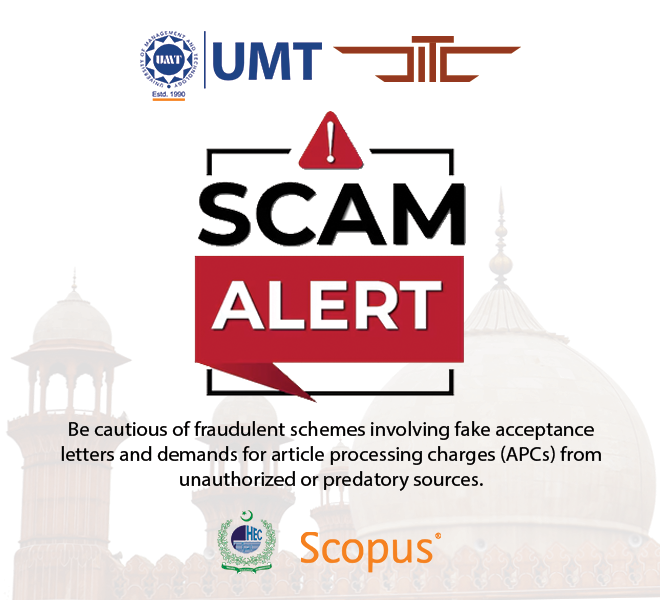Eminence and Contributions of the Companions in the Development and Teaching of the Qur’ān in the First Hijri Century
Abstract
 Abstract Views: 0
Abstract Views: 0
The process of Qur’ānic teaching in the Islamic world began during the Era of Revelation. Islamic history proves that the Qur’ān was inherited through talaqqī bi al-Mushāfahah (direct oral transmission) from teacher (murshid) to student, passing through a chain of teachers until it reaches the source of its revelation that is Prophet Muḥammad. The companions of the Prophet played a significant role in spreading the message of Islam across the world during their time by teaching the Qur’ān to the Ummah (Muslim community). A significant number of modern Muslims don't have much knowledge about Islamic history, including the vital roles played by the companions in shaping and disseminating the teachings of the Qur’an. This research aims to provide a brief overview of the early history of the development and teaching of the Qur’ān in the first century of the Hijri and explored the scholarship of the companions involved. The study utilised a literary method and a historiographical approach. Each historical fact recorded was analysed through the process based on inductive (taḥlīli), deductive (istinbāṭ), and comparative (muqāranah) methods, while relying on the historical references as primary sources authored by the Islamic scholars. The findings revealed that a significant number of companions, not only Muslim men but also women, played an essential role in disseminating the Qur’ān during the first century of the Hijri calendar.
Downloads
References
Al-‘Asqalāni, Abū al-Faḍl Aḥmad ibn ‘Aliy ibn Muḥammad ibn Aḥmad ibn Ḥajar. Al-Iṣābah fī Tamyīz al-Ṣaḥābah [Al-Iṣābah in Distinguishing the Companions]. Beirut: Dar al-Kutub al-‘Ilmiyyah, 2021.
Al-Ahwal, Jumu’ah Muhammad. Al-Qirā’āt al-Sab’ wa Isṭinbāṭ al-Aḥkām Minhā [The Seven Qur’ānic Recitations and Deriving of Rules from Them]. Benghazi: Dar al-Kutub al-Wataniyyah, 2008.
Alias, Norazman., and Nor Hafizi Yusof. “Qur’ānic Chain of Transmission: A Descriptive Study on Ijāzah of Shaykh Ḥasanayn bin Ibrāhīm ‘Āfīfī Jibrīl al-Ṭaḥūriyy (d. 1442AH/2021CE).” International Journal of Religion, Vol 5, No. 1 (2024): 56-71. https://doi.org/10.61707/f00jrq40.
Baidan, Nashruddin. Perkembangan Tafsir al-Qur’ān di Indonesia [The Development of Interpretation of the Qur’ān in Indonesia]. Jawa Tengah: Tiga Serangkai. 2003.
Al-Bukhāri, Muḥammad ibn Ismā’īl. Ṣaḥīḥ al-Bukhāri . Riyadh: Dar al-Salam, 2012.
Al-Dhahabi, Muḥammad ibn Aḥmad. Ma’rifah al-Qurrā’ al-Kibār ‘Alā al-Ṭabaqāt wa al-A’ṣār [Knowledge of the Major Qur’ānic Reciters across Generations and Eras]. Tanta: Dar al-Sahabah, 2007.
Al-Dimashqi, Ismā’īl ibn ‘Umar ibn Kathīr al-Qurashi. Al-Bidāyah wa al-Nihāyah [The Beginning and the End]. Qatar: Wizarah al-Awqaf, 2015.
Ismā’īl, Sha’bān Muḥammad. Rasm al-Muṣḥaf wa Ḍabṭuhu [The Transcription and Editing of the Qur’ān]. Cairo: Dar al-Salam, 2000.
Al-Jazari, Muḥammad ibn Muḥammad ibn Yūsuf. Munjid al-Muqri’īn wa Murshid al-Ṭālibīn [The Support of Reciters and the Guide of Students]. Cairo: Dar al-Afaq al-‘Arabiyyah, 2010.
Al-Jazari, Muḥammad ibn Muḥammad ibn Yūsuf. Ghāyah al-Nihāyah fī Ṭabaqāt al-Qurrā’ [The Ultimate Goal in the Levels of Qur’ānic Reciters]. Cairo: Dar al-Lu’lu’ah, 2017.
Al-Mas’ūl, ‘Abd al-‘Aliy. Mu’jam Muṣṭalaḥāt ‘Ilm al-Qirā’āt al-Qur’āniyyah [Dictionary of Terms in Qur’ānic Recitation Science]. Cairo: Dar al-Salam, 2011.
Al-Naysabūri, Muslim ibn al-Ḥajjāj. Ṣaḥīḥ Muslim. Beirut: Dar al-Taybah, 2006.
Al-Sajastāni, Abū Bakr ibn Abī Dāwūd ’Abdullāh ibn Sulaymān. Kitāb al-Maṣāḥif [The Book of al-Maṣāḥif]. Cairo: Dar al-Faruq al-Hadithah, 2022.
Al-Sakhāwi, ‘Ali ibn Muḥammad. Jamāl al-Qurrā’ wa Kamāl al-Iqrā’ [The Beauty of Reciters and the Perfection of Recitation]. Tanta: Dar al-Sahabah, 2010.
Al-Ṣālīh, Ṣubḥī. Mabāḥith fī ‘Ulūm al-Qur’ān [Discussions in the Sciences of the Qur’ān]. Beirut: Dar al-’Ilm li al-Malayin, 2008.
Shā’ir, ’Abd al-Mun’im Kāmil. Al-I’jāz al-Qur’āniy fī al-Rasm al-‘Uthmāniy [The Qur’ānic Miracle in Ottoman Calligraphy]. Maktabah al-Muhtadin.
Al-Shaybāni, Aḥmad ibn Muḥammad ibn Ḥanbal. Musnad al-Imām Aḥmad ibn Ḥanbal [Musnad of Imām Aḥmad ibn Ḥanbal]. Beirut: Dar al-Hadith, 2012.
Al-Suyūṭi, ‘Abd al-Raḥmān ibn Abī Bakr. Al-Itqān fī ‘Ulūm al-Qur’ān [Mastery in the Sciences of the Qur’ān]. Riyadh: Dar al-Salam, 2022.
Al-Ṭabari, Muḥammad ibn Jarīr ibn Yazīd ibn Kathīr Abū Ja’far. Jāmi’ al-Bayān ’an Ta’wīl Āy al-Qur’ān [Comprehensive Explanation of the Interpretation of the Qur’ānic Verses]. Beirut: Muassasah al-Risalah, 2012.
Al-Zarkashi, Badr al-Dīn Muḥammad ibn ‘Abdillāh. Al-Burhān fī ‘Ulūm al-Qur’ān [Evidence in the Sciences of the Qur’ān]. Beirut: Dar Ihya’ al-Kutub al-‘Arabiyyah, 2006.
Copyright (c) 2024 Norazman Alias, Nor Hafizi bin Yusof

This work is licensed under a Creative Commons Attribution 4.0 International License.

This work is licensed under a Creative Commons Attribution 4.0 International License. Authors retain copyright and grant the journal right of first publication with the work simultaneously licensed under a Creative Commons Attribution (CC-BY) 4.0 License that allows others to share the work with an acknowledgement of the work’s authorship and initial publication in this journal.








